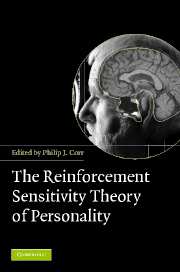Book contents
- Frontmatter
- Contents
- List of abbreviations
- List of figures
- List of tables
- List of contributors
- Preface
- 1 Reinforcement Sensitivity Theory (RST): introduction
- 2 The neuropsychology of fear and anxiety: a foundation for Reinforcement Sensitivity Theory
- 3 Animal cognition and human personality
- 4 The behavioural activation system: challenges and opportunities
- 5 Reinforcement Sensitivity Theory and personality
- 6 Reinforcement sensitivity scales
- 7 Performance and conditioning studies
- 8 Psychophysiological studies
- 9 Reinforcement Sensitivity Theory and mood induction studies
- 10 Neuro-imaging and genetics
- 11 Reinforcement Sensitivity Theory and psychosomatic medicine
- 12 RST and clinical disorders: anxiety and depression
- 13 RST and psychopathy: associations between psychopathy and the behavioral activation and inhibition systems
- 14 Behavioural activation and inhibition in social adjustment
- 15 Reinforcement sensitivity in the workplace: BIS/BAS in business
- 16 Formal and computational models of Reinforcement Sensitivity Theory
- 17 Reinforcement Sensitivity Theory: a critique from cognitive science
- 18 The contribution of Reinforcement Sensitivity Theory to personality theory
- General Index
- Index of Names
- References
12 - RST and clinical disorders: anxiety and depression
Published online by Cambridge University Press: 31 January 2011
- Frontmatter
- Contents
- List of abbreviations
- List of figures
- List of tables
- List of contributors
- Preface
- 1 Reinforcement Sensitivity Theory (RST): introduction
- 2 The neuropsychology of fear and anxiety: a foundation for Reinforcement Sensitivity Theory
- 3 Animal cognition and human personality
- 4 The behavioural activation system: challenges and opportunities
- 5 Reinforcement Sensitivity Theory and personality
- 6 Reinforcement sensitivity scales
- 7 Performance and conditioning studies
- 8 Psychophysiological studies
- 9 Reinforcement Sensitivity Theory and mood induction studies
- 10 Neuro-imaging and genetics
- 11 Reinforcement Sensitivity Theory and psychosomatic medicine
- 12 RST and clinical disorders: anxiety and depression
- 13 RST and psychopathy: associations between psychopathy and the behavioral activation and inhibition systems
- 14 Behavioural activation and inhibition in social adjustment
- 15 Reinforcement sensitivity in the workplace: BIS/BAS in business
- 16 Formal and computational models of Reinforcement Sensitivity Theory
- 17 Reinforcement Sensitivity Theory: a critique from cognitive science
- 18 The contribution of Reinforcement Sensitivity Theory to personality theory
- General Index
- Index of Names
- References
Summary
If I have seen farther than others, it is because I stand on the shoulders of giants.
Isaac NewtonTo borrow Sir Isaac Newton's metaphor, Jeffrey Gray's shoulders must be getting very sore as there are many researchers standing on them including neuroscientists, personality psychologists and psychopathologists. This is because one of the most distinctive aspects and strengths of Gray's Reinforcement Sensitivity Theory (RST) is that it bridges several levels of analysis: anatomy, physiology, motivation, conditioning, personality and psychopathology. Regarding anxiety, Gray (1982; Gray and McNaughton 2000) proposed that individual differences in reactivity of the Behavioral Inhibition System (BIS) – a sub-system of the conceptual nervous system – not only underlies the normal personality dimension of trait anxiety/neuroticism but also underlies vulnerability to the anxiety disorders. At the anatomical level, Gray (1982) originally proposed that the septo-hippocampal system (SHS) constituted the sub-system of the central nervous system that is the seat of the BIS. Gray and McNaughton (2000) expanded the neuroanatomical seat of anxiety to include the interactions of the SHS system with the amygdala.
One can derive at least three broad sets of predictions based on RST that are directly relevant for anxiety disorders and major depressive disorder (MDD). First, predictions can be derived regarding the general structure of the various symptoms of the anxiety disorders. Relatedly, RST also provides a useful framework for understanding the relations of anxiety with panic and depression.
- Type
- Chapter
- Information
- The Reinforcement Sensitivity Theory of Personality , pp. 360 - 397Publisher: Cambridge University PressPrint publication year: 2008
References
- 19
- Cited by



